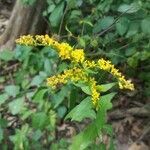Herbs, perennial; rhizomes creeping, branched. Stems 30-50 cm tall (potentially to 100 cm), erect, simple, green, shortly hirsute. Leaves: lower cauline absent at anthesis, similar to mid or upper ones but larger; mid to upper cauline numerous, lanceolate, 4.5-7 cm, tapering at both ends, margin of lower cauline sharply serrate, lateral veins multiple, prominent (not trinerved), apex acuminate; upper cauline similar, ± reduced, margin sometimes entire. Capitula very small, in secund, pyramidal, paniculiform synflorescences, branches spreading to curved downward, lower branches longest, capitula borne on one side, sometimes a few lower branches much elongated. Involucre 3-4 mm; phyllaries linear-lanceolate, apex acute to obtuse. Florets golden yellow; ray florets 3-8, lamina 1.6-1.9 mm; disk florets 3-6, 2.9-3.3 mm, lobes 0.8-1.1 mm. Pappus inner (longest) bristles not obviously clavate. Fl. Aug-Sep.
Stems 3–15(–25) dm from long creeping rhizomes, evidently spreading-hirsute (glabrous in var. sphagnophila); lvs chiefly cauline, numerous, crowded, slightly to very strongly rugose-veiny, not triple-nerved, glabrous or scabrous above, hirsute at least on the midrib and main veins beneath (except var. sphagnophila), lance-elliptic to lance-ovate or rhombic-elliptic, serrate, subsessile, not clasping, the larger ones 3.5–13 × 1.3–5 cm; infl paniculiform, with recurved-secund branches; invol 2.5–4(–5) mm, its bracts slender, not more than ca 0.6 mm wide; rays 6–11, small; disk-fls (3)4–8; achenes short-hairy; 2n=18, 36, 54. Various habitats; Nf. to Fla., w. to Mich., Mo., and Tex. (S. altissima, misapplied) Two ssp. may be distinguished, and the typical one may be divided into 3 vars., as follows:








